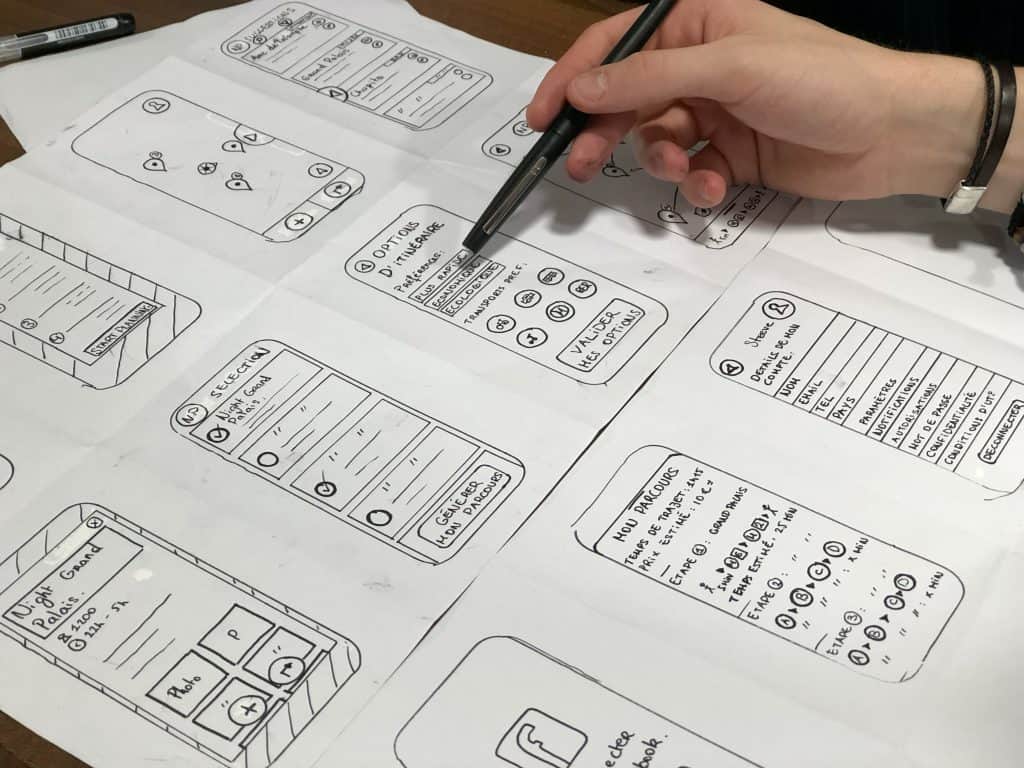In the fast-paced world of UI/UX design, collaboration emerges as the linchpin for success among leading USA companies. This blog delves into the realm of collaborative UI/UX design, exploring the best practices employed by these industry frontrunners. Discover how the power of teamwork, shared insights, and user-centric approaches is shaping the landscape of digital experiences, and learn from the strategies that have propelled these companies to the forefront of design innovation.
Collaborative UI/UX Design: Crucial for Leading USA Companies
In the fast-paced and dynamic landscape of user interface (UI) and user experience (UX) design, the role of collaboration has evolved from being optional to being essential, particularly for leading companies in the USA. Collaborative UI/UX design is not just a trend; it’s a strategic approach that drives innovation, elevates user experiences, and fosters a holistic understanding of user needs. Here’s why collaborative UI/UX design holds immense importance for the success of leading companies:
Diverse Expertise at Play:
Collaborative UI/UX design brings together professionals from various disciplines, such as designers, developers, researchers, and marketers. Each team member contributes their unique perspective, skills, and insights, enriching the design process. The convergence of diverse expertise ensures that designs are not only visually appealing but also functional, accessible, and aligned with business goals.User-Centric Solutions:
Leading USA companies prioritize user-centricity in their products and services. Collaborative UI/UX design allows for a deep understanding of user behaviors, preferences, and pain points. By involving user researchers, designers can glean valuable insights that inform every design decision. This user-focused approach results in solutions that genuinely resonate with the target audience.Innovation through Cross-Pollination:
Collaboration encourages cross-pollination of ideas. When professionals from different backgrounds collaborate, innovative solutions emerge. Ideas that may not have surfaced in isolation are nurtured through discussions, leading to breakthrough concepts. These innovative ideas position companies at the forefront of their industries, driving competitive advantage.Early Problem Identification:
Collaborative UI/UX design facilitates early identification of potential challenges. By involving developers from the outset, design concepts can be evaluated for feasibility and technical limitations. This proactive approach saves time, resources, and effort that might otherwise be wasted on designs that are difficult to implement.Iterative Improvement:
Collaborative teams are better equipped to embrace an iterative design process. Regular feedback loops ensure that designs are continuously refined based on user insights and evolving business requirements. This iterative approach leads to incremental improvements, resulting in a final product that meets user needs with precision.Shared Ownership:
In collaborative UI/UX design, team members share ownership of the project. This sense of ownership fosters commitment, accountability, and a shared vision for success. When individuals feel valued and empowered to contribute, they are more likely to invest their energy in creating outstanding designs.Faster Time-to-Market:
Collaboration streamlines the design process. Rapid ideation, prototyping, and testing can take place simultaneously due to collaborative efforts. This accelerates the time-to-market for new products and features, giving companies a competitive edge by responding swiftly to market demands.
Cultural Alignment:
Leading USA companies often have diverse teams comprising individuals from different cultures and backgrounds. The collaborative design encourages cross-cultural understanding and alignment. By considering cultural nuances, design solutions can resonate with a global audience and avoid potential misinterpretations.
Implementing Collaborative UI/UX Design: Crucial for Top USA Companies
There are a few key things to keep in mind when implementing collaborative UI/UX design:
Create a shared vision:
The first step is to create a shared vision for the product or service that everyone on the team can rally behind. This means defining the purpose of the product or service, its target audience, and its key features. It is also important to set clear goals for the design process.Foster open communication:
Once a shared vision has been created, it is important to foster open communication between everyone on the team. This means being willing to listen to different ideas and perspectives and being respectful of everyone’s contributions. It is also important to create a safe space where everyone feels comfortable sharing their ideas, even if they are not the most popular.Empower everyone to contribute:
It is important to empower everyone on the team to contribute to the design process. This means providing everyone with the opportunity to share their ideas and giving them the resources they need to be successful. This can be done by providing training on design software, project management tools, and communication tools. It is also important to create a culture of feedback where everyone feels comfortable giving and receiving feedback.Celebrate successes:
It is important to celebrate successes along the way. This will help to keep the team motivated and engaged. When the team achieves a goal, take some time to recognize their hard work and celebrate their success. This could be done with a team lunch, a round of applause, or even just a few words of praise.
Leading USA companies that are using collaborative UI/UX design to improve their products and services
GeekyAnts:
GeekyAnts is a leading USA company that provides UI/UX design services to businesses of all sizes. The company has a strong focus on collaborative design, and it works with clients to understand their needs and to create user-friendly and innovative products and services. GeekyAnts has a team of experienced designers who are skilled in a variety of design tools and techniques. The company also has a strong track record of delivering successful design projects.Google:
Google uses a variety of methods to incorporate collaborative UI/UX design into its products and services. For example, the company uses user research to understand the needs of its users, and it also uses design sprints to get feedback from users early in the design process. Google also has a number of internal design tools that help its designers collaborate more effectively.Apple:
Apple is known for its commitment to simplicity and elegance in its user interface design. The company achieves this by using a holistic approach to design, which involves close collaboration between designers, engineers, and product managers. Apple also uses a variety of user testing methods to get feedback from users and to iterate on its designs.Amazon:
Amazon is a company that is constantly innovating its user experience. The company uses collaborative design to get feedback from users and to iterate on its designs quickly. Amazon also has a number of user research tools that help it to understand user needs.Netflix:
Netflix is a company that is known for its personalized recommendations. The company uses collaborative design to understand user preferences and to create a more personalized experience. Netflix also uses data analytics to track user behavior and make recommendations that are more likely to be relevant.Spotify:
Spotify is a company that is known for its music discovery features. The company uses collaborative design to understand user listening habits and to create a more personalized experience. Spotify also uses machine learning to recommend music that is likely to appeal to users.
Conclusion
In the dynamic realm of UI/UX design, collaboration stands as the cornerstone of success for leading USA companies. As we conclude this exploration of collaborative UI/UX design best practices, it’s clear that the synergy between diverse talents, shared vision, and user-centricity drives innovation and exceptional user experiences. The insights gleaned from these leading companies underscore the significance of teamwork, effective communication, and a relentless commitment to creating digital products that resonate with users. By embracing these best practices, companies can not only meet the demands of the ever-evolving digital landscape but also set new standards for excellence and user satisfaction. As we move forward, it’s apparent that collaborative UI/UX design will continue to shape the future of design, enabling companies to craft digital experiences that inspire, engage, and enrich the lives of users.

Frequently Asked Questions
Q: What is collaborative UI/UX design, and why is it important for businesses?
A: Collaborative UI/UX design involves teamwork and input from various stakeholders to create user-friendly digital interfaces. It’s crucial for businesses because it ensures user satisfaction and competitive advantage.
Q: How do leading USA companies approach collaborative UI/UX design to enhance their products and services?
A: Leading companies prioritize cross-functional collaboration, user research, and iterative design to create exceptional user experiences, setting them apart in the market.
Q: What challenges can businesses face in implementing collaborative UI/UX design, and how can they overcome them?
A: Challenges may include communication gaps and conflicting ideas. To overcome them, companies should establish clear communication channels, defined roles, and a user-centric mindset.
Q: Are there specific tools and platforms that facilitate collaborative UI/UX design, and how do they benefit teams?
A: Yes, tools like Figma, Sketch, and collaboration platforms such as Slack streamline teamwork and enable real-time design collaboration, resulting in efficient design processes.
Q: How does user feedback influence collaborative UI/UX design, and what methods can companies use to gather valuable insights?
A: User feedback plays a vital role in refining designs. It can be collected through surveys, usability testing, and user analytics tools to inform iterative improvements.
Q: What are the key takeaways and best practices for successful collaborative UI/UX design that businesses can implement today?
A: Businesses should prioritize user needs, involve stakeholders early, iterate designs, conduct thorough user research, maintain open communication, and embrace user feedback.


















